I love fuzz pedals. I love making fuzz pedals and I love playing guitar through fuzz pedals. Although different overdrives or distortions won’t sound the same, I find the variance in sound between these types of dirty pedal is much smaller than the variance in sound you get from different fuzzes. One fuzz circuit will sound completely different from another. And I find that really fun.
There are some really famous fuzz pedals out there, and I’ve built a few of them; you can find the stripboard layout here if you want to build some of these famous fuzzes. I’m constantly amazed at how two different fuzz circuits can be miles apart in terms of tone and how the fuzz itself actually sounds.
The other thing that I love about fuzz pedals is that while they technically weren’t the first pedals to be made, they were the first to make pedals popular. Prior to fuzz effects, all the tone and sound came from the amp, and those amps were generally designed to stay clean. Turning the amp up too high pushed the tubes, giving an overdriven sound that was popular in early Rock and Roll (and it still popular today), but that’s all they had until 1962 when the first fuzz pedal was invented.
And yes, there was an effects pedal available before 1962. This was the DeArmond Tremolo controlled, first made in 1946. And while I’m not criticising the DeArmond Tremolo control, it obviously didn’t make as many waves as the first fuzz pedal if there were no further innovations for more than 15 years.
The Invention Of The First Fuzz Pedal
The first fuzz pedal was the Gibson Maestro FZ-1. It was first invented in 1962, and it wasn’t even created on purpose.
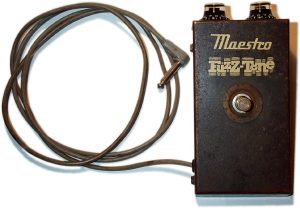
According to NPR, the inventor of the first fuzz pedal, Glen Snoddy, stumbled on the classic 1960’s fuzz sound while in the studio. Snoddy was the studio engineer for a recording session by Country music legend Marty Robbins. Although the song itself is your typical early 1960’s Nashville Country, and most of the sign has clean guitars, when they went to record the solo and outro instrumental to “Don’t Worry About Me,” a faulty transformer caused what could only be described as fuzz.
Robbins and the record producer decided to keep the fuzz sound on the final record, and the song did quite well in 1961. Well enough to get other musicians trying to figure out how to get that same sound.
Obviously you can’t reliably depend on a faulty transform, so Snoddy built a circuit that would do what the faulty transformer would do: make a sound signal sound fuzzy. This circuit was then manufactured by Gibson and the rest is history.
Like a lot of fuzz circuits, the circuit for the Maestro FZ-1 is quite simple, but also surprisingly involved compared to other early fuzzes like the Fuzz Face or Vox Tone Bender.
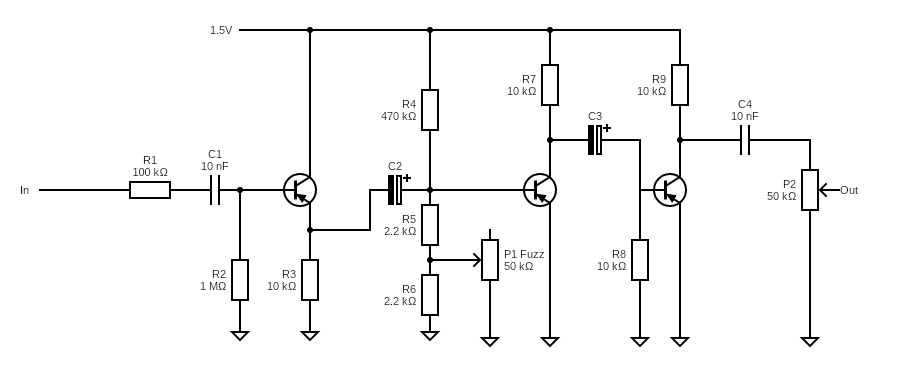
Since this was the first fuzz pedal, there really wasn’t any standard way of doing things. I imagine Snoddy understood (or figured out) that getting a transistor into its saturation region would make it start to clip. From there, Snoddy also included input and output buffers, with the three stages separated by coupling capacitors.
It’s also really interesting that this thing was designed to run off a 1.5V battery! It’s all that was needed I guess, and who knew that most pedals would start to move towards 9V in the future.
As can also be noted from the schematic, it’s a positive ground circuit design that uses PNP transistors, which is also pretty unusual these days since pretty much all guitar pedal power wiring uses negative ground.
What Songs Used The Maestro FZ-1?
The most famous use of the FZ-1 is, perhaps, by Keith Richards on the riff to “Satisfaction” by the Rolling Stones. Obviously there’s some other stuff happening there, notably reverb, but it’s a very obvious vintage style fuzz.
If you listen to the original Marty Robbins recording (which obviously didn’t use an FZ-1), and compare it to “Satisfaction”, you’ll note that Snoddy didn’t completely clone the original sound. But I reckon he found something better.
After the Maestro FZ-1 grew in popularity, other companies wanted a slice of the fuzz pie, and the 1960’s saw the creation of some of the icons we know and love so well.
Fuzz Pedals Of The 1960’s
As the 1960’s pushed on, other pedal makers tried their luck at fuzz.
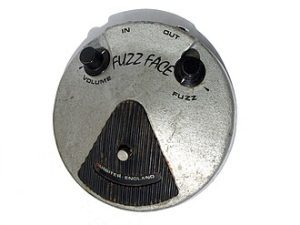 One of the more famous creations of the 1960’s included the Fuzz Face (1966), which was popularised by Jimi Hendrix. Roger Mayers’s Octavia (1967) was also used by Hendrix on songs like Purple Haze. The magic of the Octavia is that, while it provided fuzz, it also added an octave to the signal. Very cool. Both of these were British made fuzz pedals, as was the Sola Sound Tonebender (1965), which can be heard being played by Jeff Beck and Jimmy Page.
One of the more famous creations of the 1960’s included the Fuzz Face (1966), which was popularised by Jimi Hendrix. Roger Mayers’s Octavia (1967) was also used by Hendrix on songs like Purple Haze. The magic of the Octavia is that, while it provided fuzz, it also added an octave to the signal. Very cool. Both of these were British made fuzz pedals, as was the Sola Sound Tonebender (1965), which can be heard being played by Jeff Beck and Jimmy Page.
These British made pedals became popular with British players because they were more affordable and easier to get in England when compared to the American made FZ-1, and you can tell how these really shaped the sound of English Rock in the 1960’s. The pedals I mentioned don’t have that same super tight, and often quite aggressive, fuzz sound that you hear out of an FZ-1. Instead, it’s a fuzzier fuzz that’s a bit looser.
As the 1960’s closed out, American company Electro-Harmonix brought us the Big Muff in 1969. Again, I find this a tighter sound to its British counterparts. Have a listen to Pink Floyd for some use of the Big Muff.
Fuzz Pedals In The 1970’s And 80’s
As the 1970’s rolled around, it seems like a lot of manufacturers got set in their ways. The big, popular fuzz boxes that I’ve listed so far were working for popular music, and those manufacturers weren’t going to change up a winning formula (beyond a few tweaks of course).
New stuff came and went and really hasn’t had the same kind of staying power as the 1960’s fuzz circuits we all know and love. Anything that was new was very much a copy or a variation of the popular fuzz circuits people had been using in the 1960’s.
With that in mind, a lot heavier genres started to come into their own in the 1970’s, and amp manufacturers started to give people dirty channels to play with. This allowed players to have a different sound from fuzz; it was distorted, but had more crunch to it. Here’s an article on the differences between distortion, fuzz, and overdrive if you’re interested.
Going further, 1977 brought the first overdrive pedal in the form of the Boss OD-1. This was followed shortly after by the Ibanez Tube Scream.
Because of this, as popular music moved into the 1980’s, popular sounds were either in distortion or overdrive, with fuzz taking a bit of a back seat. Distortion allows for a heavier sound that suited emerging genres like Punk and Metal, so it became the go to tone for popular music, even moving into the 1990’s.
Fuzz Today
Obviously I’ve jumped ahead a little bit in time because I’ve only briefly mentioned the 1990’s and haven’t even talked about the first couple of decades of the 2000’s. But again, outside of some less popular sub-genres, fuzz hasn’t been prevalent again until more recently.
I’m not saying it wasn’t used, but it wasn’t innovated on.
These days we’ve been lucky to get a bit of a revival in fuzz. We’ve seen a lot of bands in the last 20 years that have gone for a more vintage sound and with that sound comes more fuzz rather than distortion or overdrive. This has brought a little bit of innovation back to the creation of fuzz pedals, but a lot of these professional builders are still relying on the circuits pioneered in the 1960’s. No one is looking for a “new” sound, they’re just trying to refine an old one. And that’s OK.
Hobbyist guitar pedal makers love a fuzz circuit because they all sound so different. And there are some great hobbyist builders out there who are keen to try some weird stuff. All power to them I say.
What’s Your Favourite Fuzz?
At the time of writing, I’ve been obsessed with a Vox Tone Bender clone that I built. I love it. But it’s also inspired me to build some more classic circuits and be one of those guys with way too many different kinds of fuzz.
What do you like?
Related posts:
 What’s The Difference Between Overdrive, Distortion, And Fuzz?
What’s The Difference Between Overdrive, Distortion, And Fuzz?
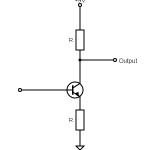 What Is Gain (And How It’s Different From Volume)
What Is Gain (And How It’s Different From Volume)
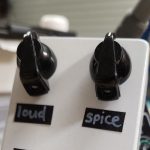 How Does A Drive, Gain, Or Distortion Knob Work?
How Does A Drive, Gain, Or Distortion Knob Work?
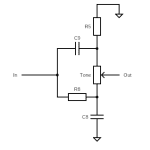 Understanding Mid-Scoops And The Big Muff Tone Circuit
Understanding Mid-Scoops And The Big Muff Tone Circuit
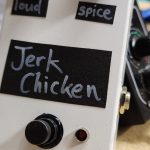 What Do Guitar Pedals Do?
What Do Guitar Pedals Do?
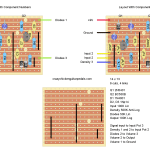 Catalinbread Karma Suture On Stripboard
Catalinbread Karma Suture On Stripboard
 Colorsound One Knob Fuzz On Stripboard
Colorsound One Knob Fuzz On Stripboard
 2024: A Year In DIY Guitar Pedals
2024: A Year In DIY Guitar Pedals
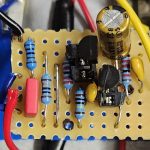 How To Make A Distortion Pedal
How To Make A Distortion Pedal
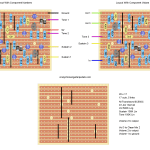 Electro-Harmonix Big Muff On Stripboard
Electro-Harmonix Big Muff On Stripboard
